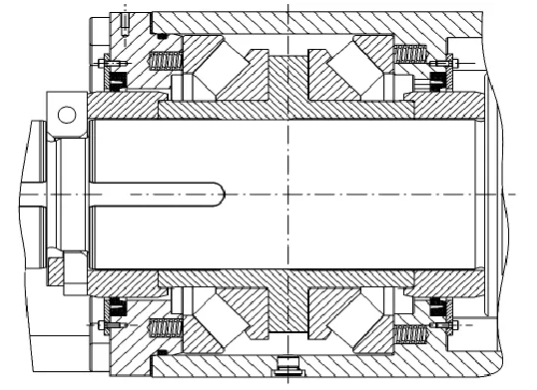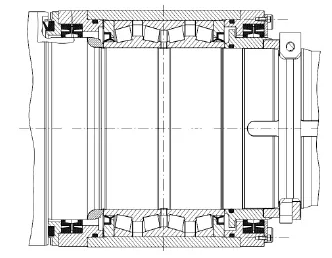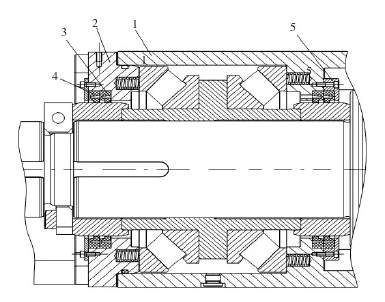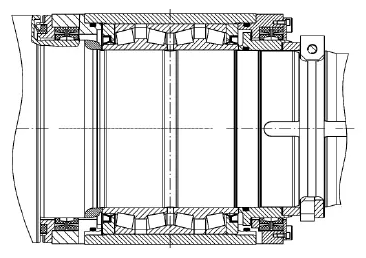
Abstract:This paper mainly analyzes the reasons of emulsification and oil leakage in the work roll and the middle roll bearing seat of cold rolling, and takes corresponding measures to extend the service life of the work roll and the middle roll bearing and save oil consumption.
Key words:Work roll; Bearing seat; Bearing seat into the emulsion; Oil leakage
The acid rolling line of the Cold rolling plant of Hegang Group Handang Co., LTD. (the following cold rolling plant of Handang) adopts SMS five-stand six-high rolling mill. Bearings and bearing lubricating oil account for a large proportion in the spare parts consumption of the rolling mill. The lubrication method of the working roll and the operating side thrust bearing of the intermediate roll adopts thin oil lubrication, which often causes oil leakage. The cost of lubricating oil use increases; The lubricating oil of the rolling mill leaks into the emulsion, resulting in the pollution of the emulsion. If there is oil leakage, do dismounting treatment, so as to increase the workload of bearing maintenance personnel. The radial bearing of the work roll and the middle roll bearing seat of the rolling mill enters the emulsion, which makes the bearing lubrication failure, causes the bearing life to be shortened, and seriously causes the on-line burning accident of the bearing, resulting in greater economic losses. Prevent bearing housing from emulsifying and reducing oil leakage, and develop corresponding measures to reduce online accidents and procurement costs.
1 Mill bearing seat into the emulsion and oil leakage
1.1 Bearing seat oil leakage
The thrust bearing on the operating side of the work roll and the intermediate roll bearing of the rolling mill is lubricated by circulating lubricating oil, and the structure diagram of the thrust bearing part of the bearing block is shown in Figure 1. From the structure diagram, it can be seen that both sides of the thrust bearing are respectively sealed by skeleton, and the bearing seat on the operating side of the work roll and the intermediate roll is often jammed and the end cap leaks oil. It is mainly due to the bearing seal failure or the axle sleeve corresponding to the seal rotation part wear seriously, due to the long time on the mill, once the sealing wear oil leakage situation, can not be stopped and replaced, because the rolling mill parking loss will be greater, can only wait until the next roll change, during this period can only allow it to leak.
There is only a single skeleton oil seal on both sides of the thrust bearing, because the seal is a consumable part, although we have a replacement cycle for the seal, during the rolling process of the mill, the temperature of the bearing seat and roll rises to more than 60 ° C, and with the vibration of the bearing and roll, as long as the skeleton oil seal lip is slightly worn, it will lead to oil leakage.

FIG. 1 Lubrication diagram of thrust bearing on operating side of work roll and intermediate roll bearing
1.2 Rolling mill bearing grease washed away by emulsion
The radial bearings of the work rolls and intermediate rolls of the cold rolling mill are lubricated by grease. During the operation of the mill, the mill emulsion is continuously washed to the bearing seat of the mill. Although the bearing seat is sealed and sealed by the emulsion, the emulsion inevitably enters the mill bearing during the rotation of the roll and seal. Rolling mill bearings are maintained in the normal cycle, up to 60% of the grease in the bearing is washed by the emulsion, most of the rolling mill bearings to be maintained after the machine is full of emulsion. However, if the emulsion entering the rolling mill bearing is not eliminated in time, it will invade the bearing and make the grease fail. When the amount of emulsion is large to a certain extent, the emulsion will wash away the grease in the bearing, seriously affecting the service life of the bearing, and even cause the bearing to burn out, resulting in serious rolling mill belt breaking accidents.
The driving side structure diagram of the work roll and the intermediate roll bearing housing of the rolling mill is shown in Figure 2 on the following page. In Figure 2, the radial bearing is lubricated by grease. The process of the emulsion entering the bearing is as follows: the emulsion rotates with the roll and the bearing, first enters the water seal, then flows into the skeleton oil seal, and finally enters the bearing seat cavity. Due to structural reasons, the emulsion trapped in the bearing seat cavity can not be discharged, and with the increase of the emulsion, the bearing will eventually soak and make the bearing oil ineffective.

FIG. 2 Schematic diagram of the driving side bearing seat of the work roll and the intermediate roll of the mill
2 Solution measures for oil leakage and emulsification of bearing seat of rolling mill
2.1 Improve the lubricating oil leakage of rolling mill bearings
For the above phenomenon, the first solution is to shorten the bearing seal replacement cycle. The bearing oil leakage situation has been improved, the shorter the cycle, the better the effect, but it is followed by an increase in the maintenance workload of the bearing seat; The solution adopted later is to improve its sealing form, from the original single skeleton oil seal on both sides to double skeleton oil seal on both sides, and add a seal on each side, so that even if one seal is damaged in online use, the other seal still works to effectively prevent the leakage of lubricating oil.
To improve the sealing form of rolling mill bearings, the improvement scheme is to increase the number of skeleton oil seals, and double skeleton oil seals are used at both ends. The specific scheme is implemented. Hangang Cold Rolling Mill has reformed the outer end cover of bearing thrust, doubling the width of the original sealing groove and allowing two seals to be installed; On the other side, the inner sealing end cover form is improved to add a seal to the original inner sealing end cover; The structure diagram of the bearing seat after the seal improvement is shown in Figure 3.

1- bearing seat chamber; 2- Outer thrust end cover; 3- Sealing slot
4- Seal; 5- Inner seal end cover
FIG. 3 Structure diagram of bearing seat after improved seal
The improved sealing structure of the rolling mill bearing seat includes a bearing seat cavity, an outer thrust end cover installed on one end of the bearing seat cavity and an inner sealing end cover installed on the inner side of the bearing seat cavity. The sealing groove is processed in the outer thrust end cover, and the two seals are installed in the sealing groove to form a double seal. A seal is installed in the inner sealing end cover, which is connected with the corresponding installation sealing part of the bearing seat cavity to form a double seal. Under the action of double sealing of lubricating oil on both sides, even if one of the seals fails, the other seal still works, which can play a good sealing role and reduce the leakage of lubricating oil.
2.2 Solution to the loss of bearing oil
According to the situation of the bearing seat in the rolling mill, the scheme to solve the bearing oil loss is formulated, the specific scheme is as follows:
The structure of bearing seat is improved so that the emulsion entering the bearing seat cavity can be removed in time. Choose to transform the bearing end cap, add the emulsion drainage tank in the lower part of the bearing seat corresponding to the bearing end cap, so that the emulsion entering the bearing can be eliminated in time, which can effectively prevent the emulsion from soaking the bearing.
The end cover of the bearing seat on the driving side and the operating side of the rolling mill is reformed respectively. The reforming scheme is to add an emulsion discharge tank to the end cover of the bearing seat.
2.3 Structural transformation of bearing seat on transmission side
According to the structural form of the bearing seat, only the end cover of the bearing seat is reformed for the sake of simplification, and the end cover of the bearing bearing on both sides of the bearing seat is reformed respectively. After the transformation, the emulsion tank is added to the end cover of the bearing bearing on the bearing side of the bearing seat and the end cover of the bearing on the collar side. The emulsion tank is 10mm wide and 1000 mm long.
The structure of the reformed rolling mill bearing is shown in Figure 4. On one side of the bearing, the bearing end cap of the emulsion sealing side and the chamber of the bearing seat are assembled to form an emulsion discharge tank with a certain size; On the other side of the bearing, the chamber assembly of the bearing end cover of the clamping ring side is also formed with a certain size of the emulsion discharge tank.

FIG. 4 Mill bearing structure after fabrication
2.4 Structural reform of the bearing seat on the operating side
One side of the operating side bearing seat is a radial bearing, and the other side is a thrust bearing. Only the bearing end cap of the radial bearing is reformed. The bearing end cap of the radial bearing in the operating side bearing seat, that is, the bearing end cap of the emulsion sealing side bearing, has the same structure as that of the emulsion sealing side bearing end cap of the transmission side bearing seat. An emulsion discharge tank with a certain size is formed. The structure diagram of the operating side bearing seat after modification is shown in Figure 5.

FIG. 5 Structure diagram of the operating side bearing seat after modification
3 Effect of measures after implementation
1) Through the transformation of the bearing seal structure, the double seal on both sides of the bearing is realized to seal the lubricating oil, and the oil leakage accident rate of the work roll and the intermediate roll is reduced to about 1/5 of the original, effectively reducing the leakage of bearing lubricating oil.
2) In the assembly of the reformed bearing end cap and the bearing seat cavity, the emulsion drainage tank formed can remove the emulsion entering the inner cavity of the bearing seat in time, effectively preventing the emulsion from soaking the bearing, resulting in the failure and loss of lubricating oil. After the improvement of the anti-emulsification measure of bearing seat, the use effect was tracked, there was no emulsion in the bearing seat, and the rolling mill bearing was disassembled. The inspection result was that the bearing did not appear emulsification and loss of lubricating oil, which effectively improved the service life of rolling mill bearing.